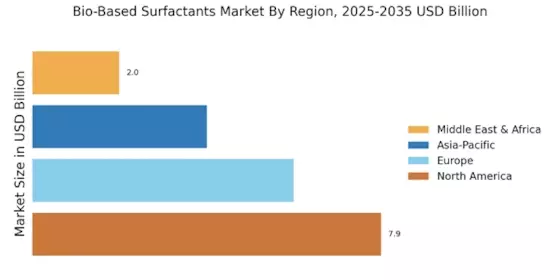Leading market players are investing heavily in research and development in order to expand their product lines, which will help the bio-based surfactants market grow even more. Market participants are also undertaking a variety of strategic activities to expand their footprint, with important market developments including new product introduction, contractual agreements, higher investments, mergers and acquisitions, and collaboration with other organizations. To enhance and survive in a more competitive and growing market climate, the bio-based surfactants industry must offer cost-effective items.
Manufacturing locally to minimize operational prices is one of the major business tactics manufacturers use in the bio-based surfactants industry to benefit clients and increase the market sector. Major players in the bio-based surfactants market, including AkzoNobel N. V (Netherland), BASF Cognis (Germany), Croda International (UK), Chemtura Corporation (USA), Ecover (Belgium), Evonik Industries (Germany), others, are attempting to increase market demand by investing in research and development operations.
BASF SE (BASF) is a chemical company. It carries out the production, marketing, and sales of chemicals, plastics, crop protection products, and performance products. Its product line comprises solvents, adhesives, surfactants, fuel additives, electronic chemicals, pigments, paints, food additives, fungicides, and herbicides. The company serves various industries, including construction, furniture and wood, agriculture, electronics and electrical, paints and coatings, automotive, home care, nutrition, chemicals, etc. BASF carries out R&D in alliance with customers, scientists, and partners. In July 2021, BASF launched a new bio-based surfactant called Dehyton AO 45.
This surfactant is made from 100% renewable raw materials and can be used in various personal care and household cleaning products.
Solvay SA is a chemical manufacturing company. It manufactures and distributes specialty polymers, essential chemicals, and chemical materials. It serves customers operating in aeronautics & automotive, natural resources & environment, electrical & electronics, agrochemical, food, consumer goods, building & construction, healthcare, industrial applications, and other sectors. The firm uses special chemicals made with eco-friendly materials to expand product quality and performance. It innovates and partners with consumers worldwide in many diverse end markets. In December 2021, Solvay launched a new bio-based surfactant called Rhovanil Natural Crystal White.
This surfactant is made from plant-based raw materials and can be used in various applications, including personal care and household cleaning products.


















Leave a Comment